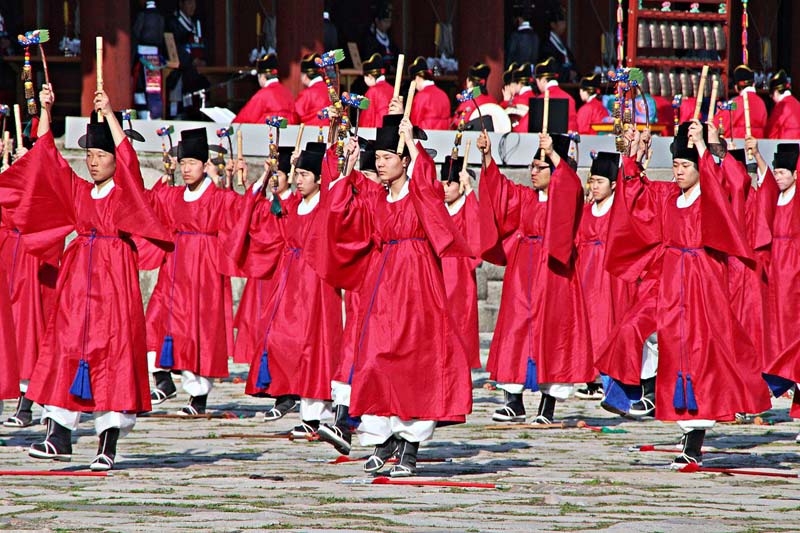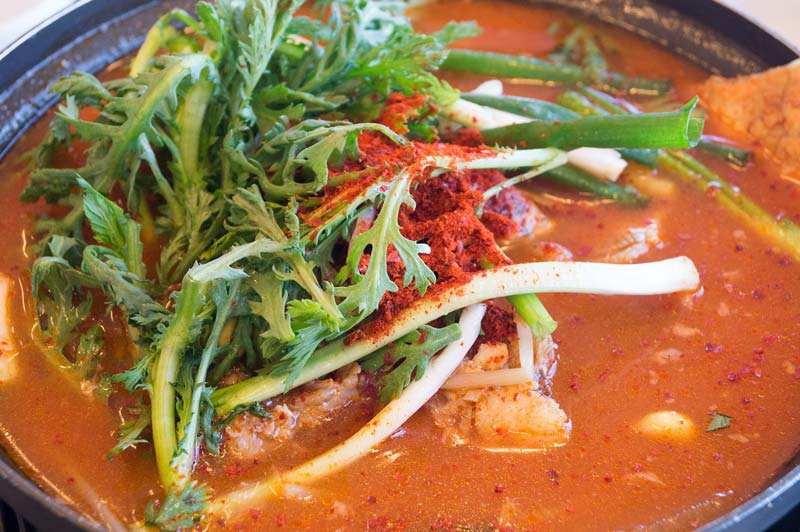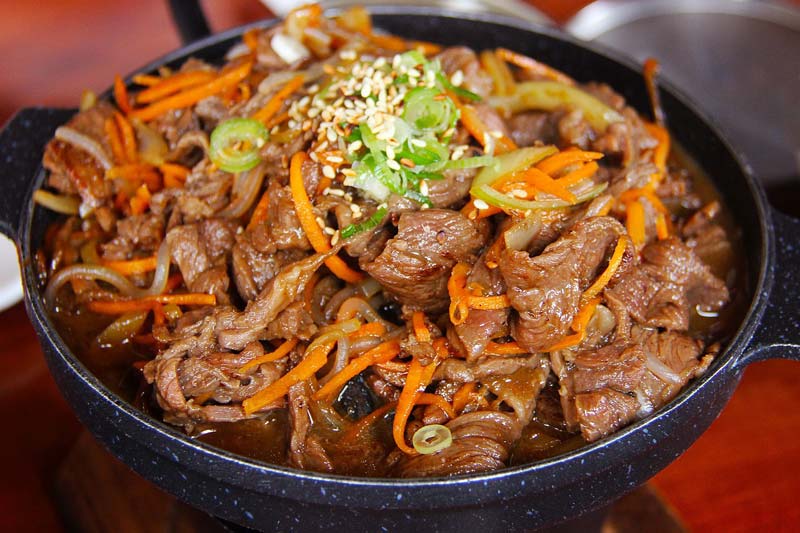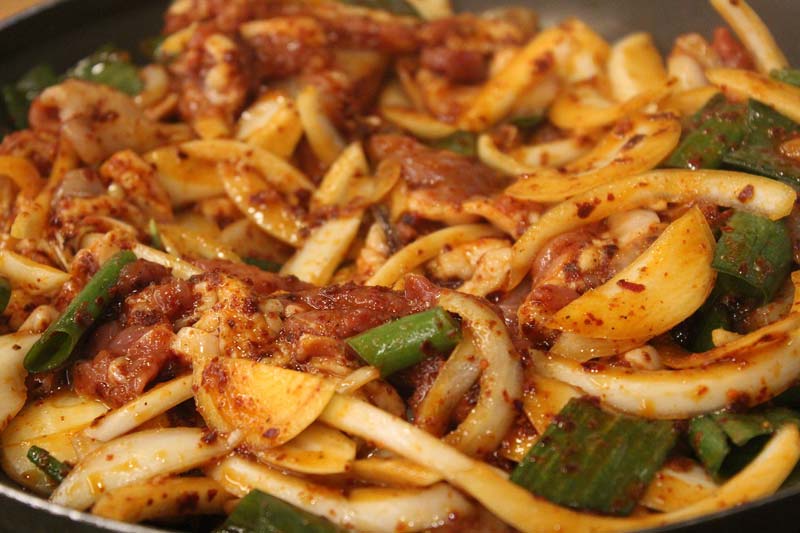Korean cuisine, celebrated for its vibrant flavors and deep cultural roots, reflects the peninsula’s four distinct seasons, fertile agriculture, and abundant marine resources. Surrounded by seas and blessed with rich rice fields, diverse grains, vegetables, and aquatic plants, Korea has cultivated a culinary tradition that harmonizes natural ingredients with time-honored techniques. From the fiery zest of fermented cabbage to the subtle warmth of seasonal soups, this cuisine emphasizes the pure taste of its components, showcasing a commitment to health, aesthetics, and cultural heritage. Prepared with sincerity and devotion, Korean food embodies not only nourishment but also the spirit of Korea’s landscapes and seasons.
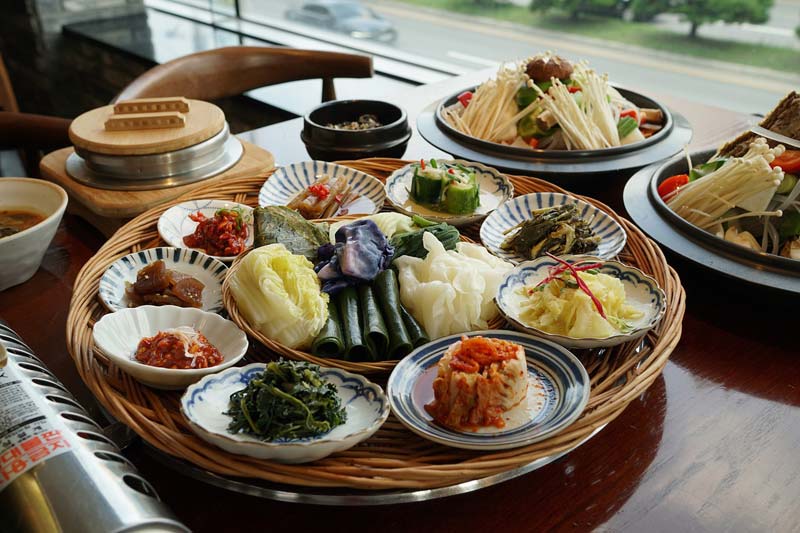
Traditional Korean Food, fot. bujobclub / pixabay
Seasonal and Regional Influences
The four distinct seasons of the Korean Peninsula shape the heart of Korean cuisine, with each season guiding the choice of ingredients and cooking methods. Spring introduces tender greens, used in fresh, lightly seasoned vegetable dishes. Summer calls for cooling meals like chilled buckwheat noodles, refreshing the palate in humid heat. Autumn’s harvest brings mushrooms and persimmons, enriching hearty stews, while winter relies on preserved foods like fermented vegetables and root vegetables to sustain through cold months. This seasonal rhythm, rooted in Korea’s agrarian history, fosters a deep connection to the land, with dishes tailored to the climate’s ebb and flow.
Regional diversity further enriches this cuisine. Coastal Jeolla Province excels in seafood dishes, pairing pungent fermented vegetables with delicacies like fermented skate. Gangwon’s mountainous terrain inspires buckwheat noodle salads accented with wild herbs. Gyeongsang’s bold flavors shine in spicy stir-fried dishes, often seasoned with red chili paste. These regional variations, shaped by geography and local traditions, highlight Korea’s ability to adapt ingredients to distinct palates while maintaining a unified culinary identity, where every dish reflects the land it comes from.
Fermentation and Preservation Techniques
A hallmark of Korean cuisine is its mastery of fermentation, a technique developed to preserve food through long winters. Fermented cabbage or radish, widely known as kimchi, is crafted with red chili powder, garlic, and ginger, creating a tangy, probiotic-rich staple that enhances digestion and flavor. Soybean paste and soy sauce, aged in earthenware jars, develop umami depth for soups and marinades. Salted seafood, such as anchovy or shrimp paste, adds savory complexity, drawing on Korea’s coastal bounty. These methods, refined since the Three Kingdoms period (57 BCE–668 CE), not only extend shelf life but also elevate nutrition and taste, aligning with traditional Korean medicine’s view of food as healing. The labor-intensive process—brining vegetables or aging pastes—reflects a cultural devotion to patience and craftsmanship, ensuring each dish carries a story of time and care.
Harmony of Flavors and Aesthetics
Korean cuisine strives for harmony, balancing taste, color, texture, temperature, and presentation. Rooted in Confucianism and traditional medicine, this philosophy views meals as both nourishment and art. A typical meal centers on rice, symbolizing life and sustenance, paired with a warm soup or stew and an array of side dishes, such as fermented vegetables, seasoned greens, or braised meats. These components create a dynamic interplay of flavors—spicy from chili paste, tangy from fermentation, and mild from broths—ensuring a balanced sensory experience.
Aesthetics are equally vital, with dishes arranged to delight the eye. Vibrant colors—red from chili, green from spinach, white from radish—echo the five elements of Korean cosmology. Ceramic bowls, bronze spoons, or lacquered trays enhance the dining experience, their shapes complementing the food’s texture and hue. Temperature varies deliberately: a steaming stew contrasts with a chilled cinnamon punch, engaging the senses fully. This meticulous attention to detail underscores the cultural value of sincerity, transforming every meal into a ritual of care and beauty.
Key Dishes and Ingredients
Rice anchors every meal in Korean cuisine, served alongside a variety of side dishes that shift with the seasons. Fermented vegetables like kimchi, with countless varieties, range from spicy cabbage to cooling radish. Soups, such as seaweed broth for birthdays or ginseng chicken soup for vitality, reflect seasonal and cultural significance. Grilled meats, like marinated beef or pork belly, are often cooked at the table, fostering communal dining. Seafood, from crispy pancakes to dried anchovies, draws on coastal abundance, while wild greens and mushrooms add earthy notes to vegetable dishes and stews.
Fermented sauces—soybean paste, red chili paste, and soy sauce—define the cuisine’s depth, enhancing dishes like mixed rice bowls or spicy rice cakes. Desserts, often understated, include rice cakes for prosperity and sweet rice drinks for festive occasions. Poultry, such as spicy stir-fried chicken, showcases regional flavors, while aquatic plants like lotus root add delicate textures. These ingredients, prepared with seasonal precision, embody Korea’s commitment to natural flavors and nutritional balance.
Modern Significance and Global Impact
Korean cuisine has soared to global prominence, propelled by the Korean Wave and UNESCO’s recognition of communal kimchi-making as intangible cultural heritage. Restaurants worldwide serve classics like mixed rice bowls, hand-cut noodle soups, and spicy stews, while fusion creations—think kimchi tacos or marinated beef burgers—blend Korean flavors with global cuisines. In Korea, families uphold traditions like communal kimchi-making, gathering to prepare fermented vegetables for winter, reinforcing community ties.
Modern dietary trends, such as veganism and health consciousness, have spurred innovations like plant-based side dishes or low-sodium kimchi, while instant noodles cater to fast-paced lifestyles. Yet, the communal ethos endures, with shared meals strengthening family and social bonds. Korean cuisine remains a vibrant expression of the peninsula’s seasonal rhythms, agricultural heritage, and cultural values, adapting to global palates while preserving its soul—a testament to Korea’s ability to balance tradition with innovation.
Glossary and References
Glossary
- Bap: Steamed rice, the cornerstone of Korean meals, symbolizing sustenance.
- Banchan: Small side dishes, such as fermented vegetables or seasoned greens, served with rice.
- Kimchi: Fermented vegetables, typically cabbage or radish, seasoned with chili, garlic, and ginger.
- Doenjang: Fermented soybean paste, used in soups and stews for umami flavor.
- Gochujang: Red chili paste, adding spice and depth to dishes.
- Ganjang: Soy sauce, a key seasoning in Korean cooking.
- Jeotgal: Salted seafood, like anchovy or shrimp paste, used for flavoring.
- Guk/Tang: Soup or stew, served warm to balance meals.
- Tteok: Rice cakes, often served during celebrations for prosperity.
- Sikhye: Sweet rice drink, a festive dessert beverage.
- Sujeonggwa: Cinnamon-flavored fruit punch, served chilled for harmony.
- Kimjang: Communal kimchi-making tradition, recognized by UNESCO.
References
- “Kimjang, Making and Sharing Kimchi.” UNESCO Intangible Cultural Heritage, https://ich.unesco.org/en/RL/kimjang-making-and-sharing-kimchi-in-the-republic-of-korea-00881.
- “Korean Traditional Food.” Korea.net, https://www.korea.net/AboutKorea/Korean-Life/Food.
- Pettid, Michael J. Korean Cuisine: An Illustrated History. Reaktion Books, 2008.
- Anderson, E. N. The Food of Korea: A Cultural History. University of Hawaii Press, 2019.
- Deuchler, Martina. The Confucian Transformation of Korea: A Study of Society and Ideology. Harvard University Press, 1992.
